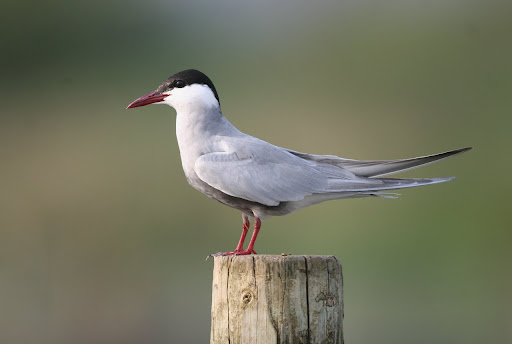
Long-tailed Shrike (Lanius schach)
Image Credit:Mekshat
This summer (2010), I made two one-weeks visits to China. The first visit was to Shanghai at the end of June to attend the World Expo. The second visit was to Hubei at the beginning of August to attend a family reunion. Like my trip to Taiwan, which was sandwiched in between the China visits, I did not get the opportunity to bird extensively as I would have liked. That being said, I did manage to do a little birding in my spare time. In all, I observed 61 species, including 14 lifers (*).
I essentially used two field guides during the trip: Mark Brazil’s Birds of East Asia (my primary guide), and MacKinnon & Philip's Field Guide to the Birds of China. My reviews for both guides can be found here.
Xihu
When I was not at the World Expo, I did a bit of birding in the park adjacent to our hotel in Shanghai. I was very disappointed. Other than a few Eurasian Tree Sparrows and some Light-vented Bulbuls, Shanghai is almost devoid of birds (and culture). In order to see birds, we made a short field trip in the neighboring province of Zhejiang - to the city of Hangzhou.

Red-billed Starling (Sturnus sericeus).
Photo credit: Martin Hale, OBC
Hangzhou is located about an hour’s train ride southwest of Shanghai. The city is home of Xihu (West Lake), a major tourist draw. Incidentally, Xihu draws large numbers of Mandarin Ducks in the winter - something I long to see. I did most of my birding in the parks adjacent to Xihu and some natural areas within a few miles of the lake.
The highlights were the Red-billed Starling and the Blue Magpie. I observed both of them near the koi pond by Baochu Pagoda. The magpie was quite racous. I observed several take off from an unseen perch in a magnolia tree and glide across the pond. The are quite a spectacular sight with their red bills and long flowing tails. Later, one perched low in a tree just a few feet from where we were sitting and stayed for a few minutes before moving on. Just across the pond, there was a pair of Red-billed Starlings straifing each other - apparently battling it out for prime perch overlooking the pond.
There were also several Eurasian Blackbirds in the park. I must say that it is the most disappointing bird I have seen in quite some time. After hearing Paul McCartney sing his poetic verses about the Blackbird on the Beatles White Album, I guess I developed something of a special affection for the bird. Upon seeing the bird for the first time, I was completely let down. The Blackbird is a downright ugly bird! I immeadiately thought of a term I have heard birders throw around when they see drab Turdus thrushes. The term is "flying turd". I think whoever coined that term did so when he was looking at a Blackbird. On a positive note, the Blackbird is quite a splendid singer. I guess you can see that his combination of looks and voice make him the Lyle Lovett of the bird world.
Here are my observations:
Barn Swallow
Vinous-throated Parrotbill
Brown-rumped Minivet *
Crested Myna
Eurasian Blackbird *
Eurasian Tree Sparrow
Great Tit *
Indian Spot-billed Duck
Japanese White-eye
Little Egret
Light-vented Bulbul
Oriental Magpie-Robin
Mallard
Blue Magpie *
Red-billed Starling *
Red-rumped Swallow *
Rock Pigeon
Spotted Dove
Black-crowned Night-Heron
Guangxi & Hubei

Limestone Mountains, Guilin China
Photo credit: olloo
We then traveled down west for a family reunion. Before heading home, we made a detour and headed down to Guilin in Guangxi province. Guilin and the neighboring area of Yangshuo are famous for their mountainous landscapes. The mountains there have been inspirational to Chinese poets and artists for thousands of years. The scenery is so spectacular that birding almost becomes secondary.

Japanese White-eye (Zosterops japonicus)
Image Credit: mononofu
We took a river trip through the mountains in Yangshuo via a bamboo raft. The Lijiang is a relatively calm river making for a very peaceful trip. Common Kingfishers and Plumbeous Water Redstarts were abundant along the river banks. In some places, the mountains rise up vertically along the banks creating a canyon. We stopped at a spot where water was running down the canyon wall. I guess it was technically a waterfall, but the volume of water coming off seemed much to low to justify calling it one. Regardless of its classification, the “waterfall” attracted lots of birds. Blue Whistling-Thrushes and White-tailed Robins darted around the base of the waterfall snatching flies. Light-vented Bulbuls hawked insects from perches in the trees. I also heard the high thin twitterings of Japanese White-eye flying overhead (listen here). The White-eye travel in small flocks of 20 or so birds, similar to our Waxwings, and are fairly abundant throughout southern China. There were also two hawks soaring overhead which I was unable to identify.

Dollarbird (Eurystomus orientalis).
Photo credit: Michelle & Peter Wong
High up on the cliff, above the waterfall (about 100 ft up), my daughter spotted a bird sitting on a small branch. It turned out to be a Dollarbird sallying for insects. Further on down the river, there was a herd of water buffalo eating vegetation. We took a detour around them. In doing so, we stumbled into a small roosting place for Collared Crows. As our raft approached, the crows took off and flew across the river directly in front of us. The white collar gave the crw the apprearance of wearing a fur stole. I never thought a crow could look so noble.

Collared Crow (Corvus torquatus).
Photo credit: Jonathan Kwong, OBC
There were also small number of fisherman on the Lijiang. Rather than using rods or nets, the fisherman were using birds - specifically Great Cormorants - to catch fish. A restrictive band is typically tied around the birds neck. The band allows the cormorants to swallow small fish, but prevents them from swallowing large fish. Upon catching a fish, the cormorant has been trained to return to the fisherman's boat where he coughs up his catch. Its all in a day's work I suppose.
Here is a list of my observations:
Black-crowned Night-Heron
Blue Whistling-Thrush
Chinese Pond-Heron *
Collared Crow *
Common Kingfisher
Common Sandpiper
Dollarbird *
Yellow-bellied Prinia
Eurasian Tree Sparrow
Crested Myna
White-tailed Robin
Greater Coucal *
Light-vented Bulbul
Plumbeous Redstart
Oriental Magpie-Robin
Red Collared-Dove
Common Tailorbird *
Vinous-throated Parrotbill
White Wagtail
Japanese White-eye

Whiskered Tern (Chlidonias hybrida).
Photo credit: Steve Hinton
We then traveled north to Huangmei in Hubei Province for a family reunion. My wife’s father left China when he was 16 to fight with Chiang Kai-shek. With the communist victory, Chiang’s troops fled to Taiwan. About 10 years ago, China and Taiwan restored relations and my father-in-law was able to return home for the first time in 50 years. Unfortunately his parents and all his siblings were gone. He did have quite a large number of cousins, nieces, nephews, etc. that still lived in the village. This trip was the first time my wife has gone to the village to see where her father grew up and to meet the rest of the family. It was a pretty moving experience to say the least.
The area where my wife’s family lives in Huangmei is pretty rural. Chickens running around the neighborhood (and through your house), livestock roaming the streets, swallows nesting in your living room, etc. The area is primarily rice paddies and cotton fields. There was also a sizeable lake behind the village that attracts lots of birds.

Chinese Pond-Heron (Ardeola bacchus).
Photo credit: Michelle & Peter Wong
In the mornings, I walked the area around the lake looking for birds. The pond was constantly patrolled by a small flock of Whiskered Terns. There were also a few Little Grebes diving for fish and several rails moving through the vegetation that I was unable to identify. Chinese Pond-Herons were ubiquitous. With there charcoal black backs, chestnut-colored heads and white tail and wings, they are quite striking birds to observe in flight. Long-tailed Shrikes were also pretty abundant in the fields adjacent to the lake. I had over 10 shrikes one morning. One began calling when I was about 30 yards away. He allowed me to approach to within 20 feet before he got uncomfortable and took off. Below is a shaky video clip of the encounter.
After the reunion, we packed up to head home. On the way to the Wuhan airport, we made a quick stop at the Li Shizhen Gardens. Li Shizhen, a distant relative of my wife, was a legendary physican and pharmacologist. He is considered by many to be the father of Chinese herbal medicine. In addition, he was perhaps the greatest naturalist in Chinese history. The Li Herbal Gardens are located about a ¼ mile from the Yangtze River and are surrounded by lots of wetlands. There were quite a few birds present in the gardens themselves, including several White Wagtails, Oriental Magpie-robins and Masked Laughingthrushes. The Laughingthrushes quicky took cover when they spotted me, but were very responsive to pishing.
Here are my observations:
Little Grebe
Little Egret
Chinese Pond-Heron
Whiskered Tern *
Common Kingfisher
Lesser Coucal
Eurasian Hoopoe
Long-tailed Shrike
Black Drongo
Pacific Swallow
Red-rumped Swallow
Light-vented Bulbul
Masked Laughingthrush
Oriental Magpie-Robin
Eurasian Blackbird
Crested Myna
Common Myna
White Wagtail
Yellow-billed Grosbeak *
Eurasian Tree Sparrow

Azure-winged Magpie (Cyanopica cyanus).
Photo credit: John Henry
The highlight of the whole trip was an Azure-winged Magpie that we saw at the Li Herbal Gardens. My daughter Maria was ahead of me on the trail and stirred the bird. She spotted it and immeadiately called my attention to it. I got a good look at it as it flew past and disappered into a grove of evergreen trees. On the way out of the gardens about 15 minutes later, I spotted it again, perched in a tree where I got an really nice view. Really a handsome bird. Even more monumental for me is the fact that it was the 500th bird on my life list.



3 comments:
Wow, that's the most beautiful starling I've ever seen!
Most starlings other than the European Starling are nice looking birds. Even the Eu Starling looks nice after a molt.
Very nice reports ! Love the Chinese Pond Heron shot.
However I have to pull you up on your assessment of Shanghai. There is an incredible amount of bird variety here ..... you were, however, in the wrong place to see it.
I live just 10 miles (16 kms) from the centre of downtown and yet have a pair of Common Kingfishers living not 100 yds from my front door. The Shanghai Botanical Gardens are also very close to downtown and a report on the bird varieties in the SBG can be found here : http://www.surfbirds.com/trip_report.php?id=302
These are the birds listed for ONE trip to the park : Kingfisher (1); Spotted Dove (6); Common Snipe (6+); Woodcock (2); Green Sandpiper (5); Common Sandpiper (3); Black-crowned Night Heron (2); Long-tailed Shrike* (4); Azure-winged Magpie (20+); White's Thrush *(1); Eurasian Blackbird( 100+);Dusky Thrush *(30+); Red-flanked Bluetail *(2); Daurian Redstart*( 3); Crested Myna (6); Great Tit (5+); Long-tailed Tit (10+); Black-throated Tit *(1);Light-vented Bulbul(100+); Pallas Warbler (10+); Yellow-browed Warbler (2); Goldcrest (1); Hwamei *(1); Vinous-throated Parrotbill* (32); Tree Sparrow (100+); White Wagtail (4); Olive-backed Pipit *(5); Siskin (5); Yellow-billed Grosbeak* (10+); probable Tristram's Bunting *(1); Black-faced Bunting* (3); 30 species in a busy city park.
Shanghai has undergone a 'greenification' since that was written so it wouldn't surprise me in the least if bird numbers & varieties had increased considerably in the interim.
Post a Comment